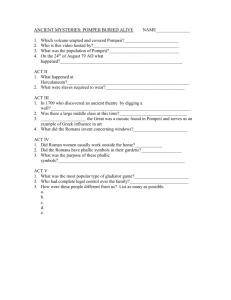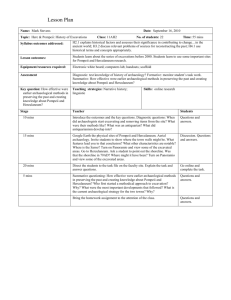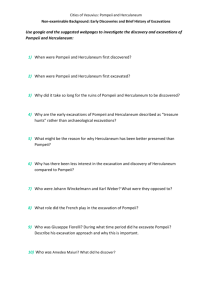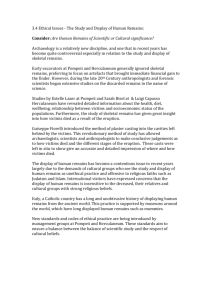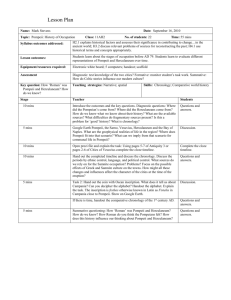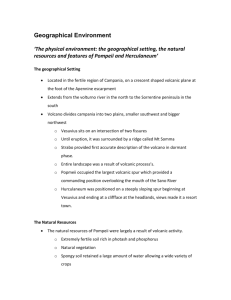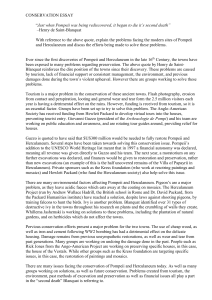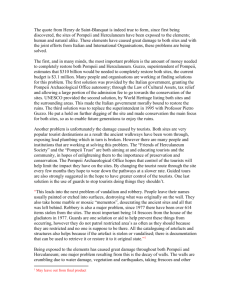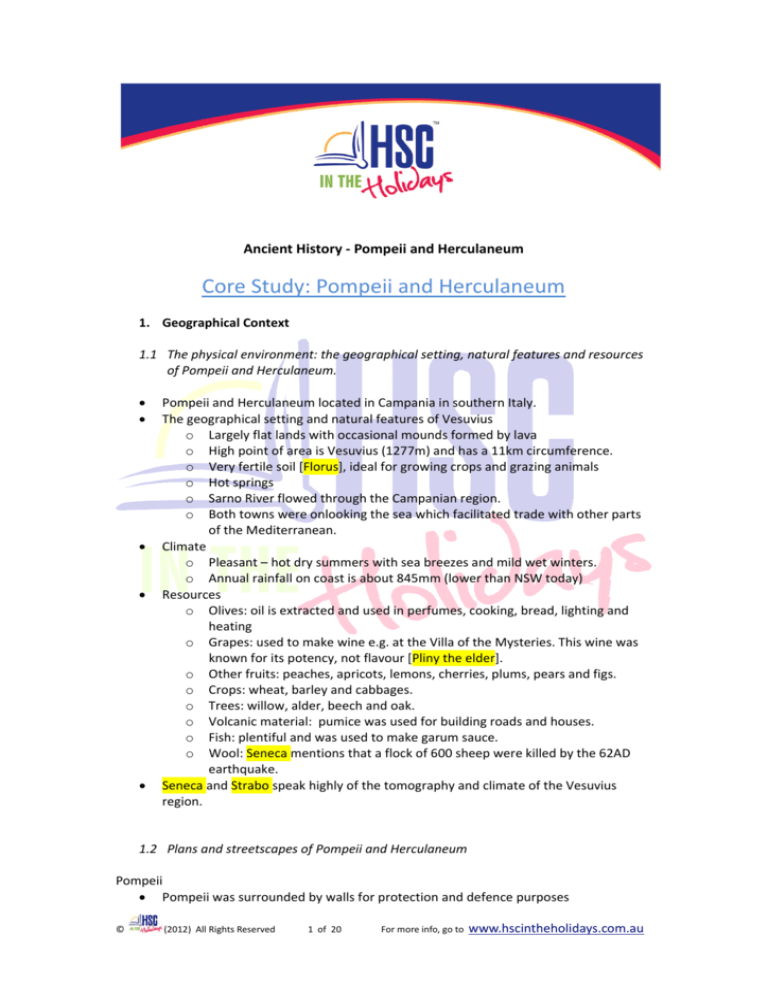
Ancient History ‐ Pompeii and Herculaneum Core Study: Pompeii and Herculaneum 1. Geographical Context 1.1 The physical environment: the geographical setting, natural features and resources of Pompeii and Herculaneum.
Pompeii and Herculaneum located in Campania in southern Italy. The geographical setting and natural features of Vesuvius o Largely flat lands with occasional mounds formed by lava o High point of area is Vesuvius (1277m) and has a 11km circumference. o Very fertile soil [Florus], ideal for growing crops and grazing animals o Hot springs o Sarno River flowed through the Campanian region. o Both towns were onlooking the sea which facilitated trade with other parts of the Mediterranean. Climate o Pleasant – hot dry summers with sea breezes and mild wet winters. o Annual rainfall on coast is about 845mm (lower than NSW today) Resources o Olives: oil is extracted and used in perfumes, cooking, bread, lighting and heating o Grapes: used to make wine e.g. at the Villa of the Mysteries. This wine was known for its potency, not flavour [Pliny the elder]. o Other fruits: peaches, apricots, lemons, cherries, plums, pears and figs. o Crops: wheat, barley and cabbages. o Trees: willow, alder, beech and oak. o Volcanic material: pumice was used for building roads and houses. o Fish: plentiful and was used to make garum sauce. o Wool: Seneca mentions that a flock of 600 sheep were killed by the 62AD earthquake. Seneca and Strabo speak highly of the tomography and climate of the Vesuvius region. 1.2 Plans and streetscapes of Pompeii and Herculaneum Pompeii Pompeii was surrounded by walls for protection and defence purposes © (2012) All Rights Reserved 1 of 20 For more info, go to www.hscintheholidays.com.au
There were 8 entrances to the town. Names based on where gates lead to, for example Herculaneum gate, Marine gate. Towers at regular intervals along the walls. Fiorelli (1860) devised a numbering system to identify houses more easily as opposed to dubious names that are based on what is inside the house, for example the House of the Faun. o Town divided into nine regions [REG] This was the 1st number noted by Roman numerals o The 2nd number is a Hindu‐Arabic number and identifies the insulate o The 3rd number is also a Hindu‐Arabic number and identifies the specific building. In Pompeii, the main streets ‘decumani’ intersected with the side streets ‘cardini’ Houses were built right up to the street. Stepping stones on road were placed perhaps when it rained to provide access across streets. They were designed to allow carts to easily pass. Herculaneum As Herculaneum is largely unexcavated, it is small and does not use region numbers, just insulae and building numbers. Houses are larger perhaps due to being a port town and many Roman Senators owning houses here. For example, Marcus Nonius Balbus. More double story houses perhaps due to the views and trying to catch the ocean breeze. Herculaneum had walls however they weren’t as extravagant as Pompeii. Similarities to both towns: Towns laid out in rectangular blocks or ‘insulae’ giving them a grid‐like pattern. This was a phil‐Hellenic influence. There is no sense of zoning, that is, separate areas for industry, commercial, recreational and residential areas. There were gutters Streets were paved and not made of dirt. 2. The nature of sources and evidence 2.1 The range of available sources, both written and archaeological, including ancient writers, official inscriptions, graffiti, wall paintings, statues, mosaics, human and animal remains.
© Ancient Writers: o Pliny the Elder wrote about the physical attributes of Campania, fish, medicinal plants, Gardens of Pompeii and other facets of commercial life. o Pliny the Younger wrote to Tacitus about his account of the eruptions of Vesuvius and the reactions and fates of the people. Pliny’s account however was 25 years after the eruption and it is biased in the sense that Pliny tried to glorify his uncle. In this regard, it may not be entirely accurate though we have archaeological evidence to support/refute what he says. o Strabo talks about the geography and climate of Campania. o Seneca talks about the Earthquake of 62AD. o Dio Cassius: He writes about the eruption of Vesuvius based on the account of people living around Naples and other cities of Vesuvius. His account was in Medieval Greek and hence its translation may lead to some ambiguities. (2012) All Rights Reserved 2 of 20 For more info, go to www.hscintheholidays.com.au
© Nevertheless, some of the things he says seem farfetched liked people gathered in masses in the theatre. This does not comply with written evidence. o Statius: A poet who referenced the ruins caused by Mt Vesuvius in Silvae. o Tacitus: Tells us about the fight between Pompeian and Nucerian spectators in AD 59 that prompted Nero to cancel gladiatorial contests for 10 years. Official Inscriptions: o Sources are evidence for the structure of government, prominent families, financial contributions to construction of public buildings as well as economic and political aspects of society. o One example is the riot between the Pompeiians and Nucerians at the Pompeii amphitheatre 59AD where Nero banned gladiatorial contests for 10 years. Graffiti o Came in two main types, inscribed or painted. o Most were propaganda messages to urge citizens to vote for a particular candidate though some were to promote gladiators. There is an issue with their interpretation as they appear fragmentary and ambiguous. o Other topics included, love, Roman bars, recreation and advertising women at brothels. o By advertising/promoting a candidate for office or win as a gladiator, a client‐patron relationship was developed: “Popidus Natalis, client, with the worshippers of Isis, proposes Cuspius Pansa as aedile”. o Messages were scratched onto the walls of houses. It seems it was an accepted practice and citizens were not annoyed at this due to many positive messages being left on the walls. o We do have an issue with the dates of when the graffiti was inscribed though in Ancient times, perhaps this could be distinguished by the ‘freshness’ of the work if it was inscribed into the cement. o By the countless number of inscriptions, it is clear that Pompeii was a literate society. Statues/Sculptures o Were in bronze or marble o Useful indicator of social status Wall Paintings (Frescoes) o Categorised into ‘Four Pompeian Styles’ devised by Augusto Mau. o It was a Hellenistic influence. o Depicted mythological scenes like ‘The Sacrifice of Iphigenia’ from the House of the Tragic Poet. Mosaics o Ranged from geometric patterns to complex designs and are composed of thousands of tesserae (tiny chips of coloured glass or stone). o Found on floors, rooves, columns and walls. o Depicted mythological scenes like in the House of the Faun (Alexander vs Darius at Issus) o Also in the House of the tragic Poet in the Vestibulum “Cave Canum”. Human and animal remains o Skeletal remains, bones and casts are a valuable source of information about victims. We can inquire into a victim’s sex, age, appearance, height, health, diet, occupation and cause of death. o Skeletons are preserved in good condition due to being covered by 20m of pumice and ash. o Unearthed remains are preserved by either epoxy resin or plaster casts. (2012) All Rights Reserved 3 of 20 For more info, go to www.hscintheholidays.com.au o
o
The Bisel sisters, namely Sara have conducted research into victims however they make spurious conclusions. Many of their conclusions are based on skeletal remains found on the beach at Herculaneum though their sample size is small and not indicative of the entire population. In terms of animal remains, dog and pig casts have been made indicating perhaps these animals were farmed and consumed by the people of Vesuvius. Also horses, mules and goats. 2.2 The limitations, reliability and evaluation of sources.
Due to the carelessness of those who have tried to excavate Pompeii and Herculaneum in the past, much of the evidence has been destroyed or stolen, leading to many gaps in our knowledge which prohibits us from making conclusive deductions on the lives of people in Vesuvius. At some points in time, there has been little documentation. With tourism and exposure to the elements, artefacts/houses/remains have been lost. We are limited by the lack of archaeological written evidence in terms of letters, poems and stories. Our conclusions are mainly based on the tangible evidence which may be only partially true. Herculaneum has been partially excavated and hence there are gaps in our understanding. This means that the conclusions we make may be false. Many of the skeletal remains are mixed together so analysis on demographics may be misleading. 2.3 The evidence provided by the sources from Pompeii and Herculaneum for: 2.3.1 The eruption Campania was an unstable volcanic region, prone to earth tremors and other seismic activity. The people had no understanding of nature or warning signs of the impending danger of Vesuvius. No exact date for the eruption can be made by the archaeological evidence due to it being ambiguous. The eruption however was in 79AD. Pliny to Tacitus: The appearance of the explosion was like a pine tree as it rose to a great height and then spread out. It appeared white, dirty and blotchy due to the mixture of Earth and ash. Buildings were being blown away from their foundations and shaking violently. Dio Cassius: People believed that the world was being wasted away into chaos. People fled though some remained in the theatre. Eruption destroyed all fish and birds. The ash even reached Syria and Egypt. Sigurdsson: In the 1980’s, he examined the grain sizes in the volcanic strata to reconstruct the phases of the eruptions. The two phases, The Plinian and Nuee Ardente are from his work. He also concluded that most people died of asphyxiation (choking/suffocation). The eruption had two phases: o Plinian phase: Initial explosion, great thrust of cloud of ash/pumice/gases from the crater formed the 33km high eruption column. It deposited upon Pompeii and was 2.5m high. For Herculaneum, only light ash and pumice feel due to NW winds blowing the cloud towards Pompeii. Whilst some people tried to flee at this time and were struck down by large rock © (2012) All Rights Reserved 4 of 20 For more info, go to www.hscintheholidays.com.au fragments or collapsing masonry, these people were a minority. The majority took refuge wherever they could. o Pyroclastic phase: Pyroclastic flows covered Pompeii. They were formed after the collapse of the eruption column. These were hot avalanches of pumice, ash and gases that were very destructive. Herculaneum was overwhelmed by a series of pyroclastic surges that were travelling at speeds up to 200km/h followed by flows. These had far greater consequences to Pompeii. Causes of death: o Baxter says of the 41 bodies he analysed, about half were consistent with asphyxiation and thermal shock. o De Carolis and Patricelli suggest through collapsing buildings and the accumulation of ash/debris. o For people struck by the pyroclastic surges, they were killed instantly. 2.3.2 The economy: trade, commerce, industries, occupations Pompeii and Herculaneum were relatively small places and therefore had small local economies. Trade: o Vital aspect of both Pompeii and Herculaneum o Pedlars came all across Campania on market day to sell their manufactured merchandise like shoes as well as plants. Perfumes, dyes and clothes also sold. o Most well known exports were wine, olive oil and garum sauce. o Pompeii imported lamps from the northern parts of Italy, pottery from Gaul, oil from southern Spain, wine from Spain, Sicily and Crete and furniture from Naples. Commerce: o 600 excavated privately owned shops, workshops, bars, taverns and inns. o Basilica was a law court and a place where businessman met clients and signed contracts. Mention Iucundus. Markets: o On both sides of the forum and were regulated by two aediles to ensure the markets ran smoothly, goods measured and priced accurately, quality maintained and city regulations were upheld. o Macellum: North East side of forum. Specialised in the sale of fish and meat. Coins have been found dating back to Nero’s time indicating this is a market. Fish scales found in underground channels indicating this was a fish market. There was also a small temple for sacrificial banquets or as an auction room and a money changing place. o Olitorium: Sold cereal and crops to individuals and bakeries. Mensa ponderia measured foodstuff. o Market day was on Saturn’s Day. Travelling Pedlars across Campania sold manufactured goodslike shoes whilst local farmers sold agricultural and garden products. o Coinage: quadran lowest coinage, Sestersius was the most widely used coin for shopping. Industry: o Centre of textiles industry. Fullones would bleach, dye, spin and weave wool. Wool was sold from the Building of Eumachia in the Fori Civili. © (2012) All Rights Reserved 5 of 20 For more info, go to www.hscintheholidays.com.au [Moeller]Perhaps, as Jongman notes, the textile industry was not as large. Example: Fullery of Stephanus. o Wine: Villas such as the Villa Regina had a torcularium and 18dolia were found for the storage and fermentation of wine. o Garum Sauce: Curtis suggests 28% of all fish sauce came from Aulus Umbricius Scaurus’ shop. o Thermopolia: 200 in Pompeii. Found in great numbers near entrances perhaps to nourish famished travellers. Largest thermopolia found in Herculaenum. o Cauponae: Most famous is Asellina’s Inn.Cooley says that cauponae are present in every insulae. o Bakeries: 28 in Pompeii, 2 in Herculaneum. Ovens are like modern pizza ovens though they are small. Evidence: carbonised loaves have been found in ovens. Bakery of Popidius Priscus at Pompeii and the Bakery of Sextus Patulcus Felix at Herculaneum. o Hotels: for visiting traders. Owners provided guests with entertainment upstairs. Sometimes foreign women. Example: Hotel of the Muses Occupations: o Banking: Wax tablets in house of Caecillius Iucundus which showed record of business transactions. o Architects: named on inscriptions on theatres at Pompeii, for example Marcus Artorius Primus. o Other occupations included door‐keeper, engraver, farmer, goldsmith, blacksmith, mason, musician, porter, sign‐writer, surgeon, teacher and wagon driver. 2.3.3 Social structure: men, women, freedmen, slaves Men: o Senatorial Elite: Romans who visited Pompeii and Herculaenum as they had villas here. Cicero the orator had a villa at Pompeii whilst Caesar’s father‐in‐
law Lucius Calpurnius Piso and proconsul Marcus Nonius Balbus had villa’s in Herculaneum. o Local Elite: these were wealthy landowners and traders who dominated local government. o The middle class: This included all freeborn males that were artisans, shopkeepers and businessman. Money was earned also by libertini that stayed in the shops of their owners. An example is the slaves of the Garum sauce merchant Aulus Umbricius Scaurus. Women o Social Status of women in the family [Cantarella and Jacobelli] Women could not marry unless they had the consent of their father ‘pater familias’ Upon their father’s death, daughters could inherit their share of the estate of equal terms with sons upper class women became rich and psychologically and socially emancipated. Women could not dispose of their property. o Social Status of women in society [Cantarella and Jacobelli]: Women became rich due to inheriting property from their family members that were male and died in wars. E.g. Julia Felix Often women were sold as slaves to earn some money and avoid dowries. © (2012) All Rights Reserved 6 of 20 For more info, go to www.hscintheholidays.com.au
Some received public honours for their life like the tomb of Mamia. In regard to education, 20% could read/write. For example the poet Sappho. Women were not confined to their houses o Marriage [Cantarella and Jacobelli]: Though a lifetime union many ended in divorce with up to three subsequent marriages perhaps to further a family’s wealth and political position. Women were able to married at 12, men 14 Ceremony started in morning with interpretation of omens and sacrifices highly superstitious society There is a banquet held at the bride’s house Walnuts are thrown over the couple to wish them fertility. o Occupations[Zarmati]: Public office like being a priestess as Mamia and Eumachia were. Business women in Taverns like Asellina and Julia Felix who was the owner of private baths. Prostitutes who worked in a lupanania. Tradeswomen who spun wool Slaves functioning as wet‐nurses, personal attendants, household slaves and cleaners Some women were in partnerships with their husbands as depicted in the fresco of the Baker Terentius Neo and his wife. His wife is shown to be holding an accounts book. o Role in Politics [Cantarella and Jacobelli]: Could not vote though they could participate in electoral campaigns Asselina’s girls vote for F. Lollius fuscus as duumvir. Freedmen ‘libertini’ o These were slaves who have been manumitted. o Many maintained a connection to their original owners which was due to a patron‐client relationship. E.g. Umbricius Abascantus. o Many took the names of their masters, for example Umbricious Abascantus. o Whilst they could not become senators, many became quite wealthy. The Vettii brothers have a luxurious house. Also Pompeiian wax tablets describe that Poppaea Note had slaves, being once a slave herself. Slaves o Bradley states that slaves through capture and auction or as an offspring of a slave mother belonged to their masters. o Cameron says that 40% of the population was slaves. o Worked in their masters businesses, see freedmen o Some had to have been paid otherwise they would not be able to buy their freedom. The vast minority however could not afford to do this. o Jobs included child carers, tutors, wet‐nurses and administration duties if they were educated. 2.3.4 Local political life Self‐administering municipalities much like modern local governments. Whilst Pompeii was generally a self‐governing town, they were subject to imperial decree by Rome. This was the case when Nero banned gladiator contests in 59AD for 10 years. Only male citizens could vote © (2012) All Rights Reserved 7 of 20 For more info, go to www.hscintheholidays.com.au
Women could not hold any position in political office. People in positions of power often had great wealth. The wealthy and powerful used their position to develop strong patron‐client relationships with citizens to gain for both, political and economic power. o Popidius Natalis, client, with the worshippers of Isis, propose Cuspius Ponsa as aedile. Whilst much graffiti is found in regard to potential candidates for office, we do not know for sure whether certain candidates were successful. [James Franklin] Apart from the status of dictator, the Comitia voted annually on the following positions: o Aediles: these were the two junior magistrates This was a prerequisite office for the duumvirship and provided people with experience before they reached more important roles. Supervised the markets, temples and streets Made public offerings. Provided public games which would have made them popular. o Duumvir: Two chief magistrates Presided over curia and courts Oversaw revenue and taxation Exercised potestas Supervised public projects and provided public games which would have earned them Gloria and dignitas. M Nonius Balbus paid for the basilica walls and doors. Had no military role/power unlike the consuls in Rome whom of which they can otherwise be compared to. Wore purple bordered white toga ‘toga praetexta’ o Quinquennales: These were duumvir elected every 5 years. They had censorial power to revise citizenship rolls and membership of the curia( appoint and dismiss). They did this when Town Councillors had died, their wealth had fallen below 10000 sesterces or they had committed some criminal or immoral action. o Town Council: They presided in the curia. Minimum age of people was 25 and they were members for life unless dismissed by Quinquennales They made local laws and were the equivalent of the Senate in Rome. o Praefectus Iure Dicundo: Appointed by the Curia to assume control of the town in an emergency like after the Earthquake of 62AD Essentially a dictator as in Rome. Outranked duumvirs 2.3.5 Everyday life: leisure activities, food and dining, clothing, health, baths, water supply and sanitation Leisure Activities o The Emperor Claudius designated 159 days yearly for holidays o Latin word for leisure is ‘otium’ o Activities included gambling, dining, partying. Others enjoyed Greek/Latin literature, exercising in the palaestra, swimming pools. Also public baths, theatres and gladiator contests. © (2012) All Rights Reserved 8 of 20 For more info, go to www.hscintheholidays.com.au
Food o
o
o
o
© 18 Dolia found in the Villa Regina for holding wine. General food found includes, bread that is carbonised, oil, wine, cheese, nuts, figs, seafood, grapes, barley, honey, eggs and fruit. Bisel says that their diets were lacking in red meat perhaps due to the amount of seafood they would have consumed. Through dental work on excavated bodies, people lacked sugar in their diet which kept their teeth healthy. They were well nourished people despite their deficiency in meat. Pliny the Elder tells us of Garum sauce made from fish guts that was dominated by Aulus Umbricious Scaurus. This is evident through mosaics found in his house. Dining o From the number of thermopolia found in Pompeii and Herculaneum, it is clear that Vesuvian citizens often ate out. This is also supported by the lack of culina in houses. o Hot food provided by thermopolia o People ate by standing up due to limited seating o They ate 3 meals a day – breakfast ‘ientaculum’, lunch ‘prandium’ and dinner ‘cena’ o Cena was the biggest meal and was eaten over three courses – i.e. was a banquet. o Banqueting was perhaps introduced by the Etruscans that showed Pompeiian’s how to enjoy food and drink. o Sweets were made for the more extravagant banquets like the Satyricon by Petronius. Clothing o Most clothing items have perished through there are pieces of fabric, shoe leather and pins found. o Clothes denoted rank and status o The Roman toga on the statue of Nonius Balbus was worn on formal occasions. o Cuirass worn by Holconius Rufus signifies he was a military tribune. o Men of high rank in the army would wear a loose tunic down to the knee and a belt. They had parallel purple stripes on front and back. Wider stripe ‘latic lavius’ for higher ranks Narrow stripe ‘angusticlavius’ for lower ranks. o Woman wore stola, depicted by Nonius Balbus’ mother. They also wore woollen head bands ‘vittae’ and palla to view head when going out. symbolised chastity and honesty Health o It is easy to determine the age of infants due to their tooth development o The bones show that 26‐30 years and 40‐50 years are the common age groups in the towns which is not typical of ancient populations which tend to have more infants and young adults. o Based on ancient writers and their own data, the Bisel sisters attribute the low birth rates with successful contraception and abortion techniques: Soranus remarks that the cervix was clogged before intercourse with woollen sponges treated with honey to prevent seminal penetration. Others endured strenuous exercises and laxatives. o Dental health better than today perhaps due to less sugar in diet, seafood that provided fluorine and the abrasive nature of foods consumed however only a few hundred skeletons have been analysed. SEE 3.2 (2012) All Rights Reserved 9 of 20 For more info, go to www.hscintheholidays.com.au o
o
Slight periodontal disease amongst older population. Lack of red meat meant 1/3 of population had anaemia, though this is still speculative. Lead levels in body high due to water pipes made out of lead. o
Baths o Those with time visited the baths regularly to meet friends, political allies and business associates. o Hot baths ‘thermae’ developed here. o Establishments include the Stabian, Forum, Central and Sarno baths. For Herculaneum, the Surburban and Central baths overlooked the sea. o Men were designated 4 days whilst women 3 days of the week to go to the baths. Genders did not mix. o Julia Felix had her own private baths for “elegant and respectable people” o Food and prostitutes brought for pleasure. o Three types of baths: the caladarium (hot room), the trepidarium (warm room) and the fridgedarium (cool room). o There was a central changing room. o A strigil was used to cleanse skin by scraping dirt off. o Oils were applied and massages were given. o The baths functioned by a hypocaustwhere hot air from underground heated furnaces would circulate in the bathing area. Water Supply o Aqueducts ran through Pompeii and Herculaneum. E.g. Aqua Augustus o Water entered a water tower ‘castellum aquae’ and flowed to different pipes by gravity. o It fed into 42 public fountains ‘impluvium’ at Pompeii and 3 at Herculaenum. Also several baths, latrines and private houses wealthy enough to afford a direct connection. o Pipes were made from lead which connected to the aqueduct. o Drainage somewhat better in Herculaneum due to a smaller population and the gradient being slightly steeper than at Herculaneum so water could past through more rapidly. Sanitation o Generally healthy place to live o Public Latrines in forum, baths and palaestra. o Normally one or toilets are found in houses however in a house, there has been place for six people. o No toilet paper, just sponge on stick for cleaning. 2.3.6 Public buildings – basilica, temples, fora, theatres, palaestra , amphitheatres. The Curia o Town Council assembled here assembled of 80‐100 influential men over 25. o Rectangular hall with an apse in the end wall. o As citizens could voice their complaints, heavy gates were used to control crowds. Tabularium: o Opposite the curia, this was where all the government business was recorded and filed, including tax records. The Basilica o Consisted of law courts and a place where contracts were signed o There were two floors.
© (2012) All Rights Reserved 10 of 20 For more info, go to www.hscintheholidays.com.au
© o Had a raised tribunal (platform) where the duumvir presided as judges. o Consisted of Corinthian and Ionic columns Temples o Temple of Jupiter: There is more fluting in the columns that in Greek Temples. In the centre of each of the drums that is part of columns is a recess and pin to hold them in place. o Temple of the Capitoline Triads: Has Corinthian Capitals Fluted columns Dedicated staircase, brick covered with marble An alter stone is on the outside of the temple. This was from prayer and libations to be made. o Temple of Fortuna Augusta: Built by Marcus Fullius Built onto an elevated platform. o Temple of Isis: Had Greek Fluted columns Had a lararium Only building completely restored after the 62AD earthquake o Temple of Venus: Corinthian capital. Her temple overlooks the sea. o Temple of Apollo: Constructed 2nd century BC Combined Helllenistic and Italian styles. Italian architecture is apparent in the staircase. The Fora o There were two forums, the Fori Civili located near the Marine Gate and the Triangular Forum o Civic Forum 40m wide, 150m long surrounded by double colonnaded portico Contained 40 statues of leading families and imperial family Forum of Hercualenum yet to be excavated as it is still buried underneath Resina. Main Building either within or adjoining forum: Temple of Jupiter, Temple of Apollo, Temple of the Lares, Temple of the Genius of Augustus, The Basilica, The Curia, the Macellum, The Eumachia building. o Triangular Forum: 95 Doric columns surrounding three sides whilst the other side faced the sea. There was a temple here that dated back to the sixth century BC due to Samnite influences. Older of two forums. Theatre: o In Pompeii built in 2nd century BC by the Holconii. It housed 5000 people o In Herculaneum, was built in the 1st century AD. It housed 2000 people o The Small theatre (Odeon) was built by C.Q. Valgus and M Porcius in 70BC. It housed 1300 people and was for music recitals oratory and meetings. o There was sectional seating. Lower rows were for magistrates and the rich, middle rows for the middle class and average citizens whilst the top was for women. (2012) All Rights Reserved 11 of 20 For more info, go to www.hscintheholidays.com.au Entertainment was free but required tokens. Patrons would often purchase tokens for their clients. o The wealthy like Nonius Balbus decorated parts of the theatre. He decorated the masonry wall. o People witnessed fires and other special effects. o Two types of plays, Atellan Farces which were like Greek Comedy with masks and exaggerated stereotypical costumes. Examples include The Castrated Boar and The Pregnant Virgin. The second was Pantomime which combined dance, mime and music. Movements were exaggerated. One performer was Pylades. Palaestra o This is where the soldiers and gladiators exercised. o Greek tradition so it consisted of a colonnaded area that provided shade and an open space for athletics o In regions VIII and II. The one in II had a swimming pool and large trees. o There was one in Herculaneum that had a pool and fountain centrepiece. Amphitheatre: o (Pompeii) Began in 70BC by duumvir C. Quintus Valgus. o Accomodated almost 20000 people. o Attracted foreigners like Nucerians as evident by the fresco of the 59AD fight between the Pompeiians and Nucerians. o Stalls set‐up outside o Games ‘munera’, included beast hunts, gladiatorial contests and athletic displays as evident by painted notices. Often men were armed differently, one with a short‐sword, shield and helmet whilst the other had a trident and a net. This made the battles more interesting due to the advantages and disadvantages of a gladiator’s weapon. o Awnings provided shade whilst scented water sprinkled to keep audience cool. 2.3.7 Private buildings – villa, houses, shops Villas: 100 have been found across the Sarno Plain. o Otium: Built purely for leisure Main features: Rooms built on different levels with terraces, a subterranean portico, expansive gardens, groves and grottoes, water displays, thermal baths, larger swimming pools. EVIDENCE: The Villa of the Papyri. 245 x 137 metres Consisted of peristyle surrounded by 36 columns, a continuous portico, and grand gardens with water features. Also had its own bath. 87 statues of bronze or marble feature animals, gods, athletes. 1800 papyrus rolls featuring Philodemus the poet/philosopher. o Villa Rusticae: Villas build on land for agricultural and pastoral production like vineyards ‘Pars urbana’were the residential quarters for the owner to stay when he visited. Had heated bath. Most of these villas are partially excavated. o
© (2012) All Rights Reserved 12 of 20 For more info, go to www.hscintheholidays.com.au
© EVIDENCE: The Villa Regina. Also the Villa of Pisanella contained rich hoard of silverware, jewels and coins that were found in the torcularium. Courtyard surrounded on three sides by porticoes. Centre of the villa featured large kitchen. Houses: o Many houses incorporated both residential and manufacturing facilities, e.g. House of Stephanus. o Most common style of Houses for the rich was the atrium‐peristyle house with a formal entrance area and colonnaded garden area. Lararia were also common. o Lighting dependant on lamps and candles. For the rich, natural light could illuminate the rooms. o Larger houses had a formal culina whilst smaller homes either had portable stoves or ate out. Perhaps not many culina due to safety reasons. o Windows were built well inside the block due to houses built so close together o House of the Faun Built 2nd Century BC during Samnite Period Named after bronze statue of the dancing faun originally on the impluvium. Famous for Alexander Vs Darius at Issus mosaic. Made from tiles rather than gravel, stone or terracotta. Fresco found that represents flora and fauna found along the Nile River. Occupies entire insulae (3000 square metres) Had Tuscan atrium, tetra style atrium, service rooms and corridors. Had private bath, culina, tablinum, cubicula, triclinia and peristyle Had tabernae. o House of the Tragic Poet Name derived from mosaic in tablinum depicting actors performing a Greek drama. Vestibulum floor depicts ‘cave canum’ though it is damaged by water and is fading On south wall of atrium was an image of Zeus and Hera on Mount Ida celebrating a woman’s loss of virginity. The other image was one of Aphrodite possibly nude but it is almost destroyed. Peristyle featured imaginary garden scene to blend in with actual garden. To the left of the peristyle is a fresco of the sacrifice of Iphigenia. o House of the Vetti Name after the Vettii brothers Aulus Vettius Coniva and Restitutus who were wealthy libertini. Has peristyle with fluted Doric columns In the atrium is a fresco of the fertility God Priapus. Has a well‐preserved lararium. o House of the Surgeon o House of Meander o House of Caecilius Jucundus Shops (tabernae): o Fullery of Stephanus example of shop combined with a house. o Asselina’s Inn o Bakery of Popidius Priscus (2012) All Rights Reserved 13 of 20 For more info, go to www.hscintheholidays.com.au 2.3.8 The Influence of Greek and Egyptian cultures: art, architecture, religion The Romans were never merely imitators and rather assimilated various cultures, techniques and ideas to produce something vibrant and unique. Art o Influenced by Greek, Etruscan, Italian and Egyptian works. o Greek: Mosaic of the battle of Alexander and Darius at Issus in the House of the Faun. o Egyptian: Fresco found in the House of the Faun represents flora and fauna found along the Nile River. o In considering arts such as poetry and philosophy, the Villa of the Papyri has many papyrus scrolls written in Greek. o Greek poetry found with lines from Homer. Architecture: o Columns: Doric: House of the Tragic Poet Ionic: Around the Temple of Apollo, Corinthian: Peristyle courtyards in private homes of Pompeii, Temple of Fortuna Augusta. o The triangular forum had the shape of the Greek Acropolis. o There is a Samnite House at Herculaneum. Religion o The people of Pompeii and Herculaneum were polytheistic. o The Capitoline Triad was worshipped – Jupiter, Juno and Minerva. o Egyptian goddess Isis was worshipped. She had a temple dedicated just to her which contained frescoes and decorations, asking for her guidance. A fresco of Isis at the Ceremony of Water shows that she was also worshipped at Herculaneum. o Greek god Dionysus was worshipped. Bacchic scene in the House of the Dioscuri in Pompeii Frescoes found in Herculaneum. o O’Connor mentions that official religious practices tended to be impersonal and those who seek a more emotional involvement were attracted to these cults and were promised happiness and salvation. 2.3.9 Religion: temples, household gods, foreign cults, tombs. General stuff on religion: o Religion bonded people to the Gods o It was also a means of uniting the entire community Temples – Refer to 2.3.6 State Gods: o Jupiter – protector of the state o Juno – Protector of women o Minerva – patroness of craftsmen. o Apollo – God of oracles and light o Venus – God of love and patron goddess of Pompeii. Also for sailors. o Collectively, Jupiter Juno and Minerva were worshipped as the Capitoline Triad in the Temple of Jupiter. © (2012) All Rights Reserved 14 of 20 For more info, go to www.hscintheholidays.com.au
© Household Gods : o Were worshipped in households are their main role was to protect it o The ‘lararium’ was the household shrine where the Lares were worshipped. A niche was dug out to place statues of households Gods here. The House of the Vettii had a well preserved lararium. o Sometimes frescoes were substitutes for statues of Gods. o The statues were dressed in country style as they were originally protectors of farms. o The ‘penates’ were protectors of stores and food o Offerings were made such as wheat, portion of meals like fruit and eggs. Even crumb droppings. On special occasions, lamb may be sacrificed. o Rituals were conducted by the paterfamilias. Foreign Cults: o Bacchus/Dionsysis: Greek God of wine and fertility Offered mystic communion with God and a promise of a blessed life after death Cult incorporated the rescue of Ariadne by Dionysus and their sacred marriage. Evidence for this is in the House of the Vettii and also the Villa of Mysteries in frescoes. Livy says that the cult spread “like a contagious disease” indicating it was quite popular. The cult could be compared to a non‐stop party/festival. The government did not approve of this cult and cracked down on the broader group of Dionysians. o Isis: Egyptian influence, Zarmati says through “foreign women” which were perhaps prostitutes. Her worship can be seen due to a shrine found in Julia Felix’s garden. Appealed to women due to their role as a mother and wife. Yearly festivals: ‘Navigation of Isis’ and ‘Isra’ Tombs: o It was illegal to bury the dead within the pomerium so that is why a large number of tombs have been uncovered along roads leading to Herculaneum, Nucerian and Nolan Gates. o No tombs uncovered at Pompeii. o Normally bodies were cremated, some were burials. Ashes were collected in terracotta/glass urns and buried. A pipe ran down to the urn to allow for the provision of libations to the remains. o Paterfamilias ensured deceased received proper burial rites. Being a superstitious society, it was believed that failure to receive proper burial rites would cause one to spend eternity as a malevolent identity. People without families paid towards a funeral fund whilst alive. o Funeral Rites: Conclamatio: relatives gathered and called out the name of the deceased person. Women prepared body for burial/cremation, washing and rubbing it with oils. A coin placed on the tongue to pay Charon the ferryman who would carry the soul to the afterlife. The body is then placed in the atrium for non‐relatives to pay their respects. (2012) All Rights Reserved 15 of 20 For more info, go to www.hscintheholidays.com.au o
o
o
Funeral processions included musicians and professional mourners ‘praeficae’. Professional mourners made the deceased seem more popular. Family members wore wax masks of the ancestors ’maiores’, so that the protectors of the family line were present, thus retaining a link between past and present. Notable tombs: the Istacidii family who were the owners of the Villa of the Mysteries. It had a large funerary chamber surmounted by a circular temple featuring statues of prominent family members. Mamia, the priestess of Venus had a semi‐circular tomb in the form of a seat which was funded by the town council. 3. Investigating, reconstructing and preserving the past 3.1 Changing methods and contributions of nineteenth and twentieth century archaeologists to our understanding of Pompeii and Herculaneum
© NOTE: If this is an assess question and says something about how contributions by archaeologists have improved our understanding of the sites or aided in the investigation/reconstruction of the past, that you actually mention these key words at the end of the paragraph to ASSESS Over time, a variety of archaeologistshave investigated Pompeii and Herculaneum , some driven by nationalism whilst others by external influences and putting self interests before the site’s welfare that has left the towns in a fragile state, requiring prompt attention in regard to preservation and conservation. Nevertheless, they have all contributed to our improved understanding of Pompeii and Herculaneum. Prior to 1860, Bourbon rulers tunnelled through the sites in search of treasure to adorn their houses. They had no respect for the ancient culture and destroyed thousands of artefacts and buildings, leaving the sites in a fragile state. Fiorelli, driven by nationalism, brought beneficiary changes to the towns. o For Pompeii, he developed a scientific numbering system to identify buildings by region, insulae and building number to remove ambiguities of previous names that relied on the contents of buildings like the House of the Faun o Published findings that increased global awareness. o Conducted meticulous excavation whilst conserving the sites however the conservation techniques were not tailored to exposure by the elements. o Developed plaster casts to preserve human/animal remains that aided in our understanding of how the eruption of Vesuvius was received through facial expressions and poses as well as clothing and footwear. o ASSESSMENT: His work was pivotal in systematically and carefully uncovering Pompeii to ensure excavation did not compromise its future but ultimately more was required. Spinazzola saw the need for restoration as highlighted by Fiorelli. o Reconstructed the streetscapes and facades of buildings and in particular the crushed upper stories of houses. This allowed tourists to understand the past by getting a glimpse of what houses looked like. o Relied on interpretation of paintings and graffiti to reconstruct unusual buildings for which he has been criticised o Reconstructed the Fullonica of Stephanus and the Inn of Asellina. (2012) All Rights Reserved 16 of 20 For more info, go to www.hscintheholidays.com.au Also left frescoes and graffiti in situ with glass coverings however this created destructive moist micro‐climates that further degraded the works. o ASSESSMENT: Despite being criticised for some of his restoration of houses and conservation techniques, Spinazzola had a positive contribution to uncovering the sites. Maiuri’s work was driven by a need to re‐establish Italy’s economy after being left devastated by WW2. o Excavated insulae on both sides of the Via dell’ Abbondanza and discovered Greek (e.g. Palaestra), Etruscan and Samnite influences on art, architecture and religion o Work completed with must haste and thus did not contain detail and scientific precision. Did not document findings nor conserve which lead to the decay and loss of many artefacts. o Examined stratigraphy of eruption and noted it coincided with Pliny the Younger’s account. o ASSESSMENT: Whilst contributing greatly to our understanding, Mariuri’s methods are a major contributing factor to the alarming state of findings today. Fausto Zevi suspended all excavation to place more emphasis on documentation and conservation of the cities due to exposure to the elements and the ever‐growing tourism industry. Excavation/conservation has become more projects based. One example is the Anglo‐American Project in region VI. o Aimed at increasing understanding of the social and economic life of Pompeii o House of the Surgeon and Vestals excavated. o Biologists, graphic experts and ceramic and paintings specialists have all collaborated in an effort to excavate efficiently whilst maintaining the sites. o Evidence for diet has been uncovered through fish, animal bones and egg shells. Whilst a variety of methods have been used to excavate Pompeii and Herculaneum, much destruction and disintegration has already occurred due to reckless digging and the conservation of the sites not being a primary focus of archaeologists . These issues must be addressed to ensure both cities are around in the future. 3.2 Changing interpretations: impact of new research and technologies o
© NOTE: If this is an assess question, make sure you tie everything back to what these techniques tell us and the fact they give us a better insight into the past New research and technologies help us the better understand Pompeii and Herculaneum as we can more easily decipher papyri as well as study skeletal and plant remains. It also allows us a glimpse of the past that might otherwise be difficult to appreciate. Digital multi‐spectral imaging in collaboration with other non‐destructive techniques is being used in the Philodemus Project at the Villa of the Papyri. Carbonised papyri that have been crushed and fused together by volcanic material can allow archaeologists to not damage the fragile papyri and gauge philosophical works that influenced Rome’s culture. CT scans have been used on the lady of Oplontis, a cast made from epoxy resin. Through this advancement, Estelle Lazer has been able to determine the woman was in her 30’s and has an irregular healing fracture. (2012) All Rights Reserved 17 of 20 For more info, go to www.hscintheholidays.com.au
Architectonical surveys allow 3D laser reconstructions that have been taking placed in the Fori Civili of Pompeii. It is also aimed at the preservation of the wall paintings of the Via dell’Abbondanza. Polymerase chain reactions enable small amounts of DNA in bones to be amplified. This enables sex, hereditary conditions and illnesses to be determined. Advancements in forensic medicine have allowed people like Lazer and Bisel to determine trends amongst citizens based on skeletal remains. o In regard to general health, there were low levels of porotic hyperostosis high hygiene and sanitation practices o Brucellosis in 10% of people, respiratory disease in 11% and two instances of tuberculosis. o Victims equally male and female. Jashemski has used a water floating technique that has allowed her to separate carbonised seeds from dirt to identify 184 different species of plants. This has enabled the reconstruction of several orchards and vineyards throughout the city. Microscope technology as used by Jay Pont in examining the composition of red clay bricks shows that the brick originated from the Bay of Naples and reflects that trade was an integral part of society. 3.3 Issues of conservation and reconstruction: Italian and international contributions and responsibilities; impact of tourism
© Issues of conservation and reconstruction: o Poor restoration work Much reconstruction work has been done by local firms that lack specialised knowledge. This has been the case with a timber room at the House of Meleager which was poorly designed and collapsed. Covering frescoes and mosaics with glass has created a moist microclimate that deteriorates the works. Spinazzola did this. o Damage from vegetation Weeds have invaded the ruins and are hastening decay by causing cracking of artefacts o Environmental factors Sunlight and rain has caused the frescoes to fade, particularly in the last 40 years. Roofs have been reconstructed. Earthquakes as in 1980 and frequent Earth tremors causes damage to both excavated and unexcavated ruins. Pigeon droppings are acidic and they continually peck at beams and doors. Contracted falconers have been used to prevent this from occurring. o Poor site protection/management Both sites subject to looting such as the frescoes found elsewhere in Italy from the House of the Chaste Lovers. The mafia has been an issue perhaps corrupting guards into doing their bidding. Bags are not checked upon entering and leaving the sites which only promotes theft. There are also an insufficient number of guards to facilitate the large crowds that enter the sites. o Other issues: Animals like stray dogs are roaming the area however most have been removed. (2012) All Rights Reserved 18 of 20 For more info, go to www.hscintheholidays.com.au
© People are allowed to eat within the houses and buildings leading to the build of rubbish. Italian and International contributions and responsibilities Italian Contributions o In 1997, the Italian government introduced a policy that all admission fees and tourist revenue would be part of the superintendants budget to put back into the site. o On July 4th 2008, Italy declared a state of emergence at the ruins of Pompeii to allow authorities to appoint a special commissioner to oversee the sites preservation and management. o Venice Charter: Outlines the main principles by which the sites and artefacts should be conserved and restored. International contributions o The Anglo‐American Project under the guidance of the Pompeii Trust has made progress in excavating in region VI by employing techniques such as architectonical 3D surveying and using the services of biologists, graphics experts and painting specialists to more meticulously excavate and spread the task of conservation and reconstruction. o The Herculaneum Conservation Project is an initiative by the Packard institute and Hadrill to prevent further damage to the sites. The work involves the consolidation of structures, improving drainage facilities to prevent water damage and using contracted falconers to address the issue of acidic pigeon droppings and pecking.This program will be eventually replaced by an ongoing maintenance program o In 1997, UNESCO has declared Pompeii and Herculaneum World Heritage Sites. Collaborative Efforts o A joint effort between the superintendant, the centre DIAPREM, the sponsoring from the firm Fassa Bortolo and the American Foundation Kacyra Family has restored some of the wall paintings of tabernae such as at Asellina’s Thermopolium. Impact of Tourism Negative impacts: o Flash photography is damaging mosaics and frescoes. o 2.5 million People visit Pompeii and Herculaneum on a regular basis however Pompeii and Herculaneum had only about 20000‐30000 residents which has caused detrimental effects to both towns. o The effects on both towns particularly Pompeii has prompted the superintendant Guzzo to declare a ‘State of Emergency’ in 2008. o Charters have been developed line the Venice Charter to outline the steps in conservation. o Theft is becoming issue with frescoes and artefacts. For example, frescoes have been hacked from the walls of the House of the Chaste Lovers that is not always open. This also leads to another issue with corruption of security. o Continued touching of artefacts can cause them to corrode or have fragments to be chipped off beyond the point of restoration. On a larger scale, the House of the Vettii has to be closed off for this reason whilst others are not open at all to the public. Positive impacts: o Increased global awareness of the state of these sites that is later spread through word‐of‐mouth. (2012) All Rights Reserved 19 of 20 For more info, go to www.hscintheholidays.com.au
o
Famous people like Charles Dickens and Mark Twain have both visited the sites and have documented their experiences which have been released to the public to gauge the situation at hand. International projects have been developed like the Anglo American Project that works in region VI. This helps to divide conservation into different areas and ensures the job has been done effectively. Tourisms generates revenue for the site which is put back in for conservation however in most instances, the destruction as a result of tourism exceeds the revenue gained. 3.4 Ethical issues: study and display of human remains.
The study and display of human remains is covered by the Vermillion and Tamaki Makau‐rau Accords. The Accords try to show respect and compassion for the remains whilst trying to continue scientific research as they are of great value to archaeologists and historians. We can gain insights into diets, demographic patterns and analyse how they have changed over time, compare life expectancy and predict future population trends. Scholars such as Baxter, De Carolis, Patricelli and Mastrolorenzo have shown that there were differences in the way victims died depending on where they were at their time of death. It must be noted that victims of Vesuvius did not receive cultural funerary rights but were buried by a natural disaster. In essence, we are retrieving bodies much like a post‐mortem without disturbing cultural practices. In regard to the display of remains, they give visitors an understanding of what people looked like at the time of their deaths. The issue however is that there is no warning for visitors about to witness these remains which can create sensitivities for certain cultures. As time inhibits consulting the relatives of the dead, the Vermillion and Tamaki Accords grant the permission of display up to the Superintendant. This too however causes a conflict in interests. Perhaps the local people should have a greater say in the display of remains as underlined by the Tamaki Makau‐rau Accord. That being said, tourism is generated which is funded back into the site which is of the essence at the moment. © (2012) All Rights Reserved 20 of 20 For more info, go to www.hscintheholidays.com.au

